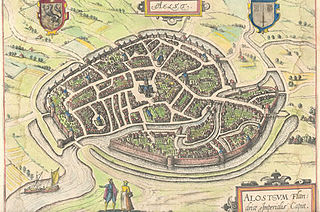 W
WThe Capture of Aalst of 1584, also known as the Betrayal of Aalst, took place in early February, 1584, at Aalst, County of Aalst, Flanders, during the Eighty Years' War and the Anglo-Spanish War (1585–1604). In 1584, after the successful Spanish military campaign of 1583, the Governor-General Don Alexander Farnese, Prince of Parma, was focused in subjecting by hunger the cities located on the Scheldt and its tributaries. One of these cities was Aalst, located on the Dender river. In January, the garrison of Aalst, composed of English troops under the command of Governor Olivier van den Tympel, was completely surrounded and blocked by the Spanish forces led by Parma. In this situation, the English soldiers, tired of the lack of supplies and pay, finally surrendered the city to Parma, in exchange for 128,250 florins and entered the service of the Spanish army.
 W
WThe siege of Alkmaar (1573) was a turning point in the Eighty Years' War. The burghers of the Dutch city of Alkmaar held off the Spanish between 21 August and 8 October 1573, with boiling tar and burning branches from their renewed city walls. On 23 September William the Silent followed up on a request by Cabeliau dating from the beginning of the siege and ordered the dikes surrounding Alkmaar to be breached, thereby flooding the polders in which the Spanish troops were camped, like the Achtermeer polder. This forced the Spanish commander, Don Fadrique, the son of the hated Alva himself, to retreat and the last Spanish soldiers left on 8 October 1573.
 W
WThe Fall of Antwerp on 17 August 1585 took place during the Eighty Years' War, after a siege lasting over a year from July 1584 until August 1585. The city of Antwerp was the focal point of the Protestant-dominated Dutch Revolt, but was forced to surrender to the Spanish forces. Under the terms agreed, all Protestants were given four years to settle their affairs and leave the city. Many migrated north, especially to Amsterdam, which became the capital of the Dutch Republic. Apart from losing a high proportion of its mercantile population, Antwerp's trade suffered for two centuries as Dutch forts blockaded the River Scheldt up to 1795.
 W
WThe siege of Bergen op Zoom was a siege that took place during the Eighty Years' War and the Anglo–Spanish War between September 23 - November 13, 1588. The siege was between a besieged Anglo-Dutch force under Thomas Morgan and Peregrine Bertie and a Spanish besieging force under famed commander Alexander Farnese, the Duke of Parma. An English officer Grimstone claimed to be a disaffected Catholic, had set up a trap during which a large Spanish assault was then bloodily repulsed. An Anglo-Dutch relief column under the command Maurice of Orange soon after arrived and forced the Duke of Parma to retreat, thus ending the siege.
 W
WThe siege of Bergen op Zoom (1622) was a siege during the Eighty Years' War that took place from 18 July to 2 October 1622. The Spanish general Ambrosio Spinola laid siege to the Dutch city of Bergen op Zoom.
 W
WThe Capture of Breda of 1581, also known as the Haultepenne Fury, occurred on 26 – 27 July when Spanish troops under the command of Claude de Berlaymont, lord of Haultepenne, took Breda by surprise after a sentry was bribed by a follower of the king, Charles de Gavre, who was kept a prisoner at the castle. The corrupt sentry allowed the Spanish troops to enter the castle.
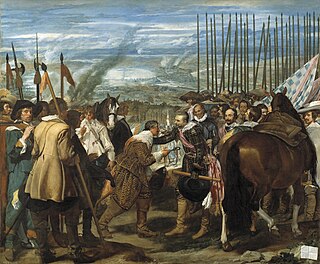 W
WThe siege of Breda of 1624–25 occurred during the Eighty Years' War. The siege resulted in Breda, a Dutch fortified city, falling into the control of the Army of Flanders.
 W
WThe fifth siege of Breda was an important siege in the Eighty Years' War in which stadtholder Frederick Henry, Prince of Orange retook the city of Breda, which had last changed hands in 1625 when the Spanish general Ambrogio Spinola conquered it for the Spanish Habsburgs. Hereafter, the city would remain in the hands of the Dutch Republic until the end of the war.
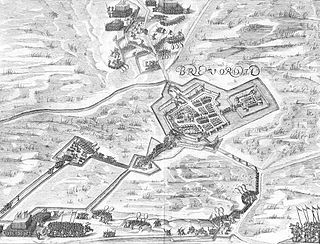 W
WThe siege of Bredevoort in 1597 was a siege of Bredevoort by the military forces led by Maurice of Nassau, Prince of Orange, during the Eighty Years War and the Anglo-Spanish War. The siege lasted from 1 October until 9 October; after that day Bredevoort was occupied by the besiegers. The siege was part of a campaign during which Maurice conquered the cities Turnhout, Alphen, Rijnberk, Meurs, Bredevoort, Groenlo, Goor, Enschede, Oldenzaal, Ootmarsum, and Lingen.
 W
WThe siege of Coevorden was a siege that took place between 26 July and 2 September 1592 during the Eighty Years' War and the Anglo–Spanish War at the city of Coevorden by a Dutch and English force under overall command of Maurice of Nassau. The city was defended by Frederik van den Bergh who had been commissioned for the defence by King Philip II of Spain.
 W
WThe siege of Coevorden was a thirty-one-week siege of the city of Coevorden in the province of Drenthe by the Spanish general Francisco Verdugo during the Eighty Years' War and the Anglo–Spanish War. The siege first commenced in October 1593, but winter and shortages of food and supplies forced the Spanish into winter quarters. The siege however recommenced in March 1594, but on May 6 Maurice of Orange arrived with an Anglo-Dutch army to relieve Coevorden, forcing the Spanish army under Francisco Verdugo to retreat.
 W
WThe Capture of Delfzijl took place during the Eighty Years' War and the Anglo–Spanish War by a Dutch and English army led by Maurice of Orange. The siege commenced on 26 June and lasted until the Spanish troops surrendered the city of Delfzijl on 2 July 1591.
 W
WThe Siege of Deventer was a siege of the city of Deventer by States troops under George van Lalaing, count of Rennenberg, from 3 August to 19 November 1578 during the Eighty Years' War. It was besieged in an attempt by the States-General of the Netherlands to better protect the regions of Holland and Utrecht from Spanish plundering. Since 1572 the city had been held by the German Polweiler-regiment for the Spanish Empire on behalf of Don John of Austria. After Lalaing had put into practice a number of pieces of strategic advice from Johan van den Kornput, the city was prepared to negotiate a surrender and on 19 November 1578 handed itself over to States troops.
 W
WThe siege of Deventer was a siege of the city of Deventer from 1 to 10 June 1591 during the Eighty Years' War by Dutch and English troops under Maurice of Nassau in an attempt to retake it from its Spanish garrison, commanded by Herman van den Bergh on behalf of the Spanish.
 W
WThe Capture of Enschede took place during the Eighty Years' War and the Anglo–Spanish War on 18 and 19 October 1597. A Dutch and English army led by Maurice of Orange took the city after a very short siege and threatening that they would destroy the city. The siege was part of Maurice's campaign of 1597, a successful offensive against the Spaniards during what the Dutch call the Ten Glory Years.
 W
WThe Capture of Geertruidenberg was a military event that took place on August 28, 1573 during the Eighty Years' War and the Anglo–Spanish War. The capture was conducted by an English, French Huguenot, and Fleming force led by Colonel de Poyet. A small assault force led by Walter Morgan captured the main gate which enabled the complete surprise of the garrison, most of whom were put to the sword.
 W
WThe siege of Grave, also known as the capture of Grave of 1586, took place from mid-February to 7 June 1586 at Grave, Duchy of Brabant, Low Countries, between the Spanish army led by Governor-General Don Alexander Farnese, Prince of Parma, and the Dutch-States and English forces under Baron Peter van Hemart, Governor of Grave, during the Eighty Years' War and the Anglo-Spanish War (1585–1604).
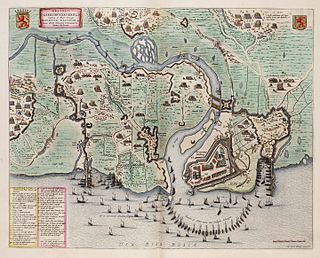 W
WThe siege of Geertruidenberg was a siege of the city of Geertruidenberg that took place between 27 March and 24 June 1593 during the Eighty Years' War and the Anglo–Spanish War. Anglo-Dutch troops under the commands of Maurice of Nassau and Francis Vere laid siege to the Spanish garrisoned city. The siege was unique in that the besiegers used a hundred ships, forming a semicircle in a chain on the Mass river to form a blockade. A Spanish relief force under the command of the Count of Mansfeld was attempted in May but this was defeated and he was later forced to withdraw. Three Governors of the city were killed - after the last fatality and as a result of the failed relief, the Spanish surrendered the city on 24 June 1593. The victory earned Maurice much fame and had thus become a steadfast strategist in the art of war.
 W
WThe siege of Ghent during the Eighty Years' War by Spanish general Alexander Farnese, Prince of Parma, lasted from October 1583 to 17 September 1584. It was the end phase of the so-called Calvinist Republic of Ghent, which had controlled most of the County of Flanders since radical Protestants seized power on 28 October 1577, claiming a leading role for the city of Ghent in the struggle against the Spanish royal forces and Malcontent Catholics.
 W
WIn August 1572, during the course of the Eighty Years' War, the city of Goes, in the Spanish Netherlands, was besieged by Dutch forces with the support of English troops sent by Queen Elizabeth I. This was a menace to the safety of the nearby city of Middelburg, also under siege. Given the impossibility of rescue of Goes by sea, 3,000 soldiers of the Spanish Tercios under the command of Cristóbal de Mondragón waded across the river Scheldt at its mouth, walking 15 miles overnight in water up to chest deep. The surprise arrival of the Tercios forced the withdrawal of the Anglo-Dutch troops from Goes, allowing the Spanish to maintain control of Middelburg, capital of Walcheren Island.
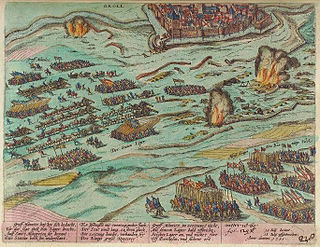 W
WThe siege of Grol or Groenlo in 1595 was a siege of Groenlo by States forces under Maurice of Nassau during the Eighty Years' War in an attempt to capture it from the Spanish Empire. It lasted from 14 to 24 July 1595, ending with the arrival of a Spanish relief force under Cristóbal de Mondragón and Maurice's retreat. Two years later, in 1597, Maurice returned to carry out another siege of Groenlo. Both these sieges formed part of what would later be called the Ten Glorious Years.
 W
WThe siege of Groenlo was a siege of Groenlo during the Eighty Years' War and the Anglo–Spanish War by a Dutch and English army led by Maurice of Nassau after it had followed an unsuccessful siege by Maurice in 1595.
 W
WThe siege of Groenlo was a siege of Groenlo or Grol in 1606 during the Dutch Revolt. It lasted from 3 to 14 August 1606 and ended in the city being captured from the United Provinces by a Spanish Empire force under Ambrosio Spinola. A few months later Prince Maurice attempted to retake the city but failed due to poor planning and an intervention by Spinola. Groenlo would remain in Spanish hands until another siege in 1627.
 W
WThe siege of Grol in 1627 was a battle between the Army of the Dutch Republic, commanded by Frederick Henry, Prince of Orange, and the Spanish-controlled fortified city of Grol, during the Eighty Years War and the Anglo–Spanish War in 1627. The Spanish Army, led by Hendrik van den Bergh, came to relieve Grol but too late. The siege lasted from 20 July until 19 August 1627, resulting in the surrender of the city to the Dutch army.
 W
WThe siege of Groningen was a two-month siege which commenced on 19 May 1594, and which took place during the Eighty Years' War and the Anglo-Spanish War. The Spanish-held city of Groningen was besieged by a Dutch and English army led by Prince Maurice of Orange. The Spanish surrendered the city on 22 July, after a failed relief attempt by the Count of Fuentes.
 W
WThe siege of Haarlem was an episode of the Eighty Years' War. From 11 December 1572 to 13 July 1573 an army of Philip II of Spain laid bloody siege to the city of Haarlem in the Netherlands, whose loyalties had begun wavering during the previous summer. After the naval battle of Haarlemmermeer and the defeat of a land relief force, the starving city surrendered and the garrison was massacred. The resistance nonetheless was taken as an heroic example by the Orangists at the sieges of Alkmaar and Leiden.
 W
WThe siege of 's-Hertogenbosch of 1601 (Sitio de Bolduque de 1601 in Spanish) was an unsuccessful Dutch attempt led by Prince Maurice of Nassau and William Louis of Nassau-Dillenburg to capture the city of 's-Hertogenbosch, North Brabant, Spanish Netherlands, garrisoned by about 1,500–2,000 Spanish soldiers led by Governor Anthonie Schetz, Baron of Grobbendonck, between 1 and 27 November 1601, during the Eighty Years' War and the Anglo-Spanish War (1585–1604), in the context of the long and bloodiest siege of Ostend.
 W
WThe siege of 's-Hertogenbosch also known as the siege of Bois-Le-Duc was an action in 1629, during the Eighty Years' War and the Anglo–Spanish War in which a Dutch and English army captured the city of 's-Hertogenbosch. The city had been loyal to the King of Spain since 1579 and was part of the Spanish Netherlands.
 W
WThe siege of Hulst was a siege of the city of Hulst that took place between 20 and 24 September 1591 by a Dutch and English army under the leadership of Maurice of Orange during the Eighty Years' War and the Anglo–Spanish War. The siege was part of Maurice's famous campaign of 1591.
 W
WThe siege of Huy of 1595, also known as the assault of Huy, was a Spanish victory that took place between 7 and 20 March 1595, at Huy, Archbishopric of Liège, Low Countries, as part of the Eighty Years' War, the French Wars of Religion, and the Anglo-Spanish War (1585–1604).
 W
WThe siege of Jülich was a siege that took place between 5 September 1621 and 3 February 1622, during the Palatinate campaign of the Thirty Years' War. After five months of siege the Spanish army under Ambrosio Spinola took the Dutch-occupied fortress of Jülich, compelling its garrison to surrender.
 W
WThe Siege of Knodsenburg, Relief of Knodzenburg or also known as Battle of the Betuwe was a military action that took place during the Eighty Years' War and the Anglo–Spanish War at a sconce known as Knodsenburg in the district of Nijmegen. A siege by a Spanish army under the command of the Duke of Parma took place from 15th to the 25th July 1591. The fort was defended by the Dutch Republic's commander Gerrit de Jong and his company which was then subsequently relieved through the intervention of a Dutch and English army led by Maurice of Orange and Francis Vere respectively on July 25. As a result, the Spanish army was defeated and Parma managed to retreat by getting his army across the River Waal.
 W
WThe siege of Leiden occurred during the Eighty Years' War and the Anglo–Spanish War in 1573 and 1574, when the Spanish under Francisco de Valdez attempted to capture the rebellious city of Leiden, South Holland, the Netherlands. The siege failed when the city was successfully relieved in October 1574.
 W
WThe siege of Leuven was an important siege in the Thirty Years' War in which a Franco-Dutch army under Frederick Henry of Orange and the French Marshals Urbain de Maillé-Brezé and Gaspard III de Coligny, who had invaded the Spanish Netherlands from two sides, laid siege to the city of Leuven, defended by a force of 4,000 comprising local citizen and student militias with Walloons, Germans, Spanish and Irish of the Army of Flanders under Anthonie Schetz, Baron of Grobbendonck. Poor organization and logistics and the spread of sickness among the French, along with the appearance of a relief army of 11,000 Spanish and Italian troops under Ottavio Piccolomini, forced the invading army to lift the siege. This failure allowed the Spanish forces to take the initiative and soon the invaders were forced into a headlong retreat.
 W
WThe siege of Lier of 1582, also known as the capture of Lier or betrayal of Lier, took place between 1 and 2 August 1582 at Lier, near Antwerp, during the Eighty Years' War and the Anglo-Spanish War (1585–1604). On 2 August the Spanish army commanded by Governor-General Don Alexander Farnese, Prince of Parma, supported by part of the States garrison, captured and seized the town, defeating the rest of the Dutch, English and German troops under Governor of Lier. All garrison was killed or captured. The news of the Spanish success at Lier produced a great shock to the States-General at Antwerp, where the sense of insecurity was obvious, and many of the Protestant citizens sold their houses, fleeing to the north of Flanders.
 W
WThe siege of Lochem also known as the Relief of Lochem was a siege that took place in the Dutch city of Lochem during the Eighty Years' War and the Anglo–Spanish War. The city was relieved by a States army composing of English and French Huguenot troops under Count Philip of Hohenlohe-Neuenstein and William Louis of Nassau-Dillenburg and John Norreys on September 24, 1582. This marked the end of the Spanish siege of the city by the Spanish general Francisco Verdugo.
 W
WThe siege of Maastricht was fought between 9 June and 22 August 1632, when the Dutch commander Frederick Henry, Prince of Orange, eventually captured the city from Habsburg forces.
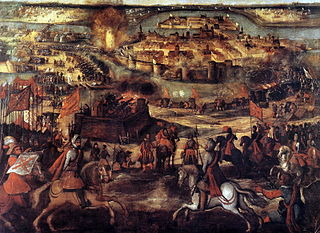 W
WThe siege of Maastricht was a battle of the Eighty Years' War which lasted from March 12 – July 1, 1579. The Spanish were victorious.
 W
WThe siege of Niezijl was a siege of the town of Niezijl that took place between 3 and 24 October 1581 in the Dutch States, during the Eighty Years' War and the Anglo-Spanish War (1585–1604). The Spanish under Colonel Francisco Verdugo laid siege to the place after his victory at the battle of Noordhorn but the siege failed and Verdrugo retreated leaving the English and Dutch under John Norreys and William Louis respectively the victors.
 W
WThe siege of Nijmegen was a military engagement during the Eighty Years' War and the Anglo–Spanish War which took place from 17 to 21 October 1591. The Spanish garrison in Nijmegen was besieged by a Dutch and English force under Maurice of Nassau and Francis Vere respectively, which soon surrendered.
 W
WThe siege of Oldenzaal was a short siege that took place during the Eighty Years' War and the Anglo–Spanish War by a Dutch and English army led by Maurice of Orange of the city of Oldenzaal from 20 to 23 October 1597. The city surrendered to the overwhelming Dutch and English force. The siege was part of Maurice's campaign of 1597 known as the Ten Glory Years, his highly successful offensive against the Spaniards.
 W
WThe siege of Oldenzaal took place in the Spanish held town of Oldenzaal in the Twente region from July 23 to August 1, 1626 during the Eighty Years' War and the Anglo–Spanish War. After an eight-day siege led by Ernest Casimir the city surrendered.
 W
WThe Capture of Ootmarsum in 1597 was a short siege, that took place during the Eighty Years' War and the Anglo–Spanish War by a Dutch and English army led by Count Van Duivenvoorde while Maurice of Nassau was besieging Oldenzaal. The siege lasted from 19 to 21 October, where the Spanish garrison of Ootmarsum under the governor, Otto Van Den Sande, surrendered and was then occupied by the besiegers. The siege was part of Maurice's successful offensive against the Spaniards during the same year.
 W
WThe siege of Ostend was a three-year siege of the city of Ostend during the Eighty Years' War and the Anglo–Spanish War. A Spanish force under Archduke Albrecht besieged the fortress being held initially by a Dutch force which was reinforced by English troops under Francis Vere, who became the town's governor. It was said "the Spanish assailed the unassailable; the Dutch defended the indefensible." The commitment of both sides in the dispute over the only Dutch-ruled area in the province of Flanders, made the campaign continue for more than any other during the war. This resulted in one of the longest and bloodiest sieges in world history: more than 100,000 people were killed, wounded, or succumbed to disease during the siege.
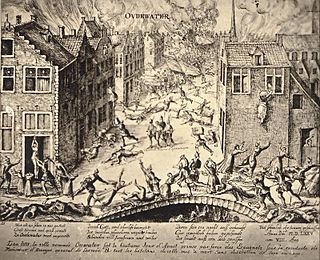 W
WThe siege of Oudewater was an event during the Eighty Years' War that took place in the Dutch town of Oudewater, culminating in the Oudewater Massacre. The siege by Spanish troops started on 19 July 1575 and ended on 7 August 1575, when the town was taken by storm and plundered.
 W
WThe siege of Rees of 1599, also known as the relief of Rees, was an unsuccessful attempt by Protestant-German forces led by Count Simon VI of Lippe, and Anglo-Dutch forces sent by Prince Maurice of Nassau, commanded by Philip of Hohenlohe-Neuenstein and the Count Ernst of Solms, to capture the strategic stronghold of Rees, Lower Rhine, Duchy of Cleves from the Spanish forces of Don Francisco de Mendoza, Admiral of Aragon, second-in-command of the Army of Flanders, and Governor Don Ramiro de Guzmán, between 10–12 September 1599, during the Eighty Years' War and the Anglo-Spanish War (1585–1604). This Spanish victory was part of the campaign of Francisco de Mendoza and Cardinal Andrew of Austria of 1598-1599, also called the Spanish Winter of 1598-99.
 W
WThe siege of Rheinberg 1586–1590, also known as the capture of Rheinberg of 1590, took place at the strategic Cologne enclave of Rheinberg, one of the principal crossing-points over the Rhine on the stretch between the Electorate of Cologne and the Dutch border, between 13 August 1586 and 3 February 1590, during the Eighty Years' War, the Cologne War, and the Anglo-Spanish War (1585–1604). After an initial siege in 1586, and a long blocking by the Spanish forces until September 1589, Don Alexander Farnese, Duke of Parma (Spanish: Alejandro Farnesio), commander-in-chief of the Spanish army, sent a substantial force, under Peter Ernst, Count of Mansfeld, to besiege Rheinberg. Despite the efforts by Maarten Schenck van Nydeggen, and Sir Francis Vere, to relieve the fortress city, the Protestant garrison finally surrendered to the Spaniards on 3 February 1590.
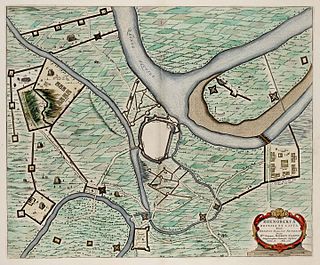 W
WThe siege of Rheinberg, also known as the Rhine campaign of 1601, was the siege of the towns of Rheinberg and Meurs from 12 June to 2 August 1601 during the Eighty Years' War and the Anglo–Spanish War. Maurice of Orange with an Anglo-Dutch army besieged the Spanish-held cities in part to distract them before their impending siege at Ostend. Rheinberg, an important city, eventually capitulated on 28 July after a Spanish relief force under Herman van den Bergh failed to relieve the city. The towns of Meurs surrendered soon after.
 W
WThe siege of Schenkenschans was a siege that took place from 28 April to 2 May 1599 as part of the Eighty Years' War and the Anglo–Spanish War. Schenkenschans was garrisoned largely by English troops and was besieged by a Spanish force led by Francisco de Mendoza. The siege failed with losses and the Spanish were forced to retreat when a relief force arrived.
 W
WThe siege of Schenkenschans was a major siege of the Eighty Years' War. In a successful campaign the Army of Flanders, commanded by Spanish general Cardinal-Infante Ferdinand of Austria, captured Schenkenschans along with a number of important towns, reversing recent Dutch gains and opening the Dutch Republic to a possible invasion. The Dutch Stadtholder, Fredrick Henry, pushed the republic's military efforts to their limit to recapture the fortress of Schenkenschans to counter the threat to the exposed Dutch heartland. He succeeded in doing so after a costly nine month siege.
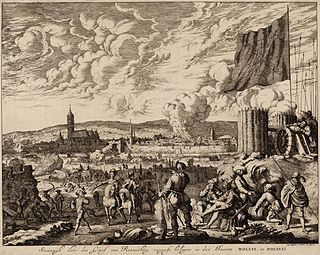 W
WThe siege of Steenwijk took place from October 18, 1580 – February 23, 1581 during the Eighty Years' War and the Anglo–Spanish War, between a besieging Spanish force under turncoat George van Lalaing against a Dutch rebel garrison at Steenwijk under Johan van den Kornput. An English and Dutch rebel force under John Norreys successfully relieved the town on January 24, and the Spanish in addition to ill-health and lack of supplies subsequently lifted the siege in February.
 W
WThe siege of Steenwijk was a siege that took place between 30 May and 5 July 1592 as part of the Eighty Years' War and the Anglo–Spanish War by a Dutch and English force under Maurice of Orange. By taking Steenwijk the Republic's army would take out one of the two main transport routes overland to the Drenthe capital of Groningen, the other lay at Coevorden. After a failed bombardment, an assault was made in conjunction with the detonation of mines under important bastions, and with two out of three successfully assaulted, the Spanish troops surrendered on 5 July 1592 and handed over the city to the Dutch and English army. This siege was one of the first in history to make use of pioneers as a separate military unit although they were still at the time regarded as soldiers.
 W
WThe siege of Valenciennes took place between 6 December 1566 and 23 March 1567 at Valenciennes, then in the Habsburg Netherlands. It is considered the first siege of the Eighty Years' War. Among the victims of the repression that followed the fall of the city was the author of the Belgic Confession, Guido de Bres.
 W
WThe siege of Venlo of 1586, also known as the Capture of Venlo, was a Spanish victory that took place on June 28, 1586, at the city of Venlo, in the southeastern of Low Countries, near the German border, between the Spanish forces commanded by Governor-General Don Alexander Farnese, Prince of Parma, and the Dutch garrison of Venlo, supported by relief troops under Maarten Schenck van Nydeggen and Sir Roger Williams, during the Eighty Years' War and the Anglo-Spanish War (1585–1604). After two failed attempts to relieve the city, the siege ended on June 28, 1586, with the capitulation and the withdrawal of the Dutch garrison.
 W
WThe siege of Venlo was an important siege in the Eighty Years' War that lasted from 20 to 25 August 1637. The Cardinal-Infante Ferdinand of Austria, Governor of the Spanish Netherlands, retook the city of Venlo from the United Provinces, which had taken control of it in 1632 during the offensive of Frederick Henry, Prince of Orange against Maastricht. The capture of Venlo and Roermond, which was surrendered to the Cardinal-Infante a week later, effectively cut Maastricht from the Dutch Republic, thus preventing further attacks on the Spanish Netherlands from the east. In the southern front Ferdinand lost the towns of La Capelle, Landrecies, and Damvillers to the French, but then he forced them to retreat south of Maubeuge.
 W
WThe siege of Zaltbommel was a campaign that took place during the Eighty Years' War and the Anglo–Spanish War from May 15 to July 22, 1599. The Spanish led by Francisco López de Mendoza y Mendoza launched an offensive campaign around Bommelerwaard, which was defended by an Anglo-Dutch force under the command of Maurice of Orange. A siege on the town of Zaltbommel by Spanish troops was attempted but they had to lift the siege and were defeated in subsequent attempts to regain the initiative. Mendoza retreated and the Spanish army then found itself in chaos: mutinies took effect and as a result further operations were suspended for a number of years. As a result, the Dutch and English followed with a counter-offensive in the Spanish Netherlands.
 W
WThe siege of Zutphen was an eleven-day siege of the city of Zutphen by Dutch and English troops led by Maurice of Nassau, during the Eighty Years' War and the Anglo–Spanish War. The siege began on 19 May 1591 after a clever ruse by the besiegers. The city was then besieged for eleven days, after which the Spanish garrison surrendered.